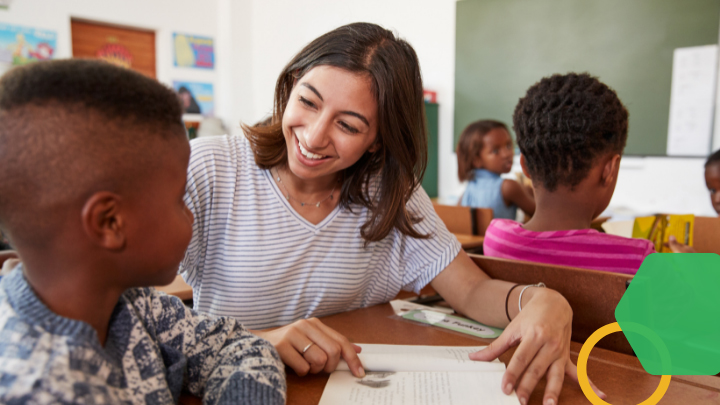Returning after winter break can be a challenge for students, but to reframe our thinking as teachers and leaders, let’s think of it as an opportunity for a fresh start. It can be an opportunity to refresh our classrooms, revisit our class agreements, class goals, personal goals, and think about our own hopes, dreams, and vision for the remainder of the school year. It can be an opportunity to make important changes to improve learning and help your students to grow.
The strategies below support trauma-informed teaching through creating safe spaces, establishing positive behavior systems, and focusing on resilience and well-being for both students and teachers. Most of these tools and techniques can be adapted to any learning environment whether you are in the classroom, remote, or in a hybrid experience. The unpredictability of the current situation necessitates consistency and careful attention to students’ social-emotional needs. Choose what will work best for your group of students and your learning environment. There is no sequence or “must do” in the list below; it’s all about what will support you and your students. As a teacher and a leader, it is best practice to try out these tips on your own or with colleagues before implementing them in your classroom.
1. Acknowledge, validate, and discuss how students are feeling
As students reenter the classroom after winter break, they bring in a variety of feelings, emotions, and experiences which can have an impact on the classroom and students’ learning. Students benefit from tools, structure, and strategies to discuss, understand, and regulate their emotions. This is particularly important to creating a safe space in your classroom for students to be able to share their feelings with one another.
- Check in with students’ emotions as part of your morning meeting routine. If you don’t have a morning meeting established, consider making that part of your classroom. Morning meetings are a consistent way in which to develop a culture of care and a positive learning environment.
- Choose one tool that will become a consistent part of your classroom culture. For example, use a tool like the emotion wheel, the mood meter or this video to help students to identify and regulate their emotions as well as create an emotions vocabulary.
- Using an emotional thermometer can also help students to identify and reflect upon their emotions. Students will learn to identify the situations that trigger their emotions as well as sense the signs in their bodies that can manifest into bigger emotions.
- An emoji feeling chart can help students to identify their own emotions and build community by sharing emotions with peers. It can also be a visual reminder or cue system for emotions, especially for younger students or students that struggle with reading.
2. Rebuild the class community
Just as students are welcomed into the classroom at the start of a new school year, think about how to make all students feel welcome. It is also important to continue to build the connections between students, deepen their understanding of one another, and build and strengthen their relationships.
- Try establishing a class greeting for welcoming students into the classroom.
- Consider having a class mascot that can unite the students in your classroom.
- Have fun together by playing short games and engaging in group activities.
3. Revisit and revise goals
Many of us often start off the new year with new year’s resolutions. Consider how to set students up for success by setting both personal and classroom goals. Goals allow students to take ownership over their learning and bring awareness to their strengths and areas for growth.
- One effective tool for developing goals is to help students to set SMART goals and provide a class routine to continually monitor and reflect upon their progress
- Another strategy is to establish a learning contract to provide a framework and steps for achieving their goals.
- Set goals as a class through collective goal setting using “We Can” statements and focusing on specific learning targets.
4. Revisit and revise classroom rules and procedures
While you already have rules and procedures established in your classroom, it may be a good time to revisit them and discover ways in which they can be improved. This is one of the many ways you can focus on student-centered learning. When students have a voice in their classroom, it builds a culture of care and positivity. Positive behavior systems are a form of trauma informed teaching that creates a healthy learning community.
- Start by revising your class agreements and rules When class rules are created at the start of the school year, students have not yet had the opportunity to get to know one another and understand one another’s needs. By revisiting the classroom rules, students can reflect on the year so far and have the opportunity to make changes in their classroom. Consider the ways in which SEL is promoted within the classroom rules.
- Create or revisit norms for collaboration for small groups and partnerships to reflect on what is working or not working in the classroom community. Students can think about how they support one another and what they would like to change.
5. Provide opportunities for students to learn about self-regulation
Students may re-enter the classroom feeling dysregulated after so much time away. By providing the tools, awareness, and means to regulate, students will be more ready and available for learning. These trauma-informed practices will help students to develop their resilience.
- There are a variety of self-regulation strategies that can help students to shift their mood while they ease into back to school.
- When conflicts or challenging situations arise, help students to regulate their emotions by using self awareness moments. Students develop social-emotional learning through recognizing how situations trigger heightened emotions and responding to these situations by applying effective strategies. It is important for students to determine which strategies will be most effective for them.
- Another effective self-regulation strategy is to practice positive self talk.
- Practice mindfulness by using free videos and recordings from the Calm app or Headspace.
- Provide opportunities for brain breaks as students rebuild their stamina for learning. Try using tools such as Go Noodle.
6. Focus on the positive
Research has shown that engaging in positive thinking can have a beneficial impact on your health and immune system. It reduces anxiety and will lead to an increase in positive emotions including joy and happiness. Trying this practice yourself or with colleagues, and then modeling this practice with students can help students to see how to apply it in their own lives and improve their overall social emotional well-being.
- One way to focus on the positive is through practicing gratitude. This can be a daily or weekly practice that is incorporated into your routines or class meetings.
- Consider supporting positive moments in your classroom by creating a positive news board. The more students witness and celebrate positive moments, the more often they will occur.
7. Help students to develop a growth mindset
A growth mindset is defined as the belief that talents and abilities can be developed through hard work and targeted strategies. Those that have a fixed mindset believe that talents are innate gifts that are fixed and cannot be developed. Embracing a growth mindset will help students persevere through challenges because when students believe they can get smarter, they put in extra time and effort that lead to higher achievement.
- To begin supporting your students to develop a growth mindset.
- Apply a growth mindset to math, through using the resources and tools on the YouCubed website. Students will learn to appreciate the mistakes they make and see them as opportunities for growth.
8. Read a good book together
Engaging in a read-aloud together can promote listening, discussion, and comprehension skills as well as creating a shared experience that continues to build the classroom community.
- Try the Classroom Book-a-Day strategy to enforce the importance of daily literacy.
- Engage students in a read aloud about a topic of interest to them.
- Consider the concept of windows and mirrors when selecting books for your classroom.
9. Build your relationship with students
In order for students to be successful learners, it is important for them to feel known and seen by their teachers.
- Provide students the opportunity to share their experiences with you either privately or anonymously. Use the strategy I Wish My Teacher Knew to provide ways in which to share.
- Conduct individual conferences with students for a quick check in to personalize the learning experience and provide individualized feedback. Use the individual conference to review and analyze learning data in order to set goals.
10. Connect with parents
Maintaining a strong relationship is critical for students’ learning and success. Ongoing communication can support this important partnership.
- Connect with parents and caregivers by sending out communication that highlights SEL work as well as ways in which to support this work at home.
- Continue to build positive connections with families by revisiting the families’ hopes and dreams they have for their children.
Developing Social-Emotional Skills Takes Time and Consistent Practice
The strategies or practices above can be implemented at any time throughout the year. Be patient with yourself and your students as you integrate these tools and strategies into your classroom. Continue the process of reflection yourself and with your students. To learn more about SEL, you can explore our Social-Emotional Learning domain here. If you would like further support to implement Social-Emotional Learning in the classroom, a BetterLesson Instructional Coach can help you get started.





